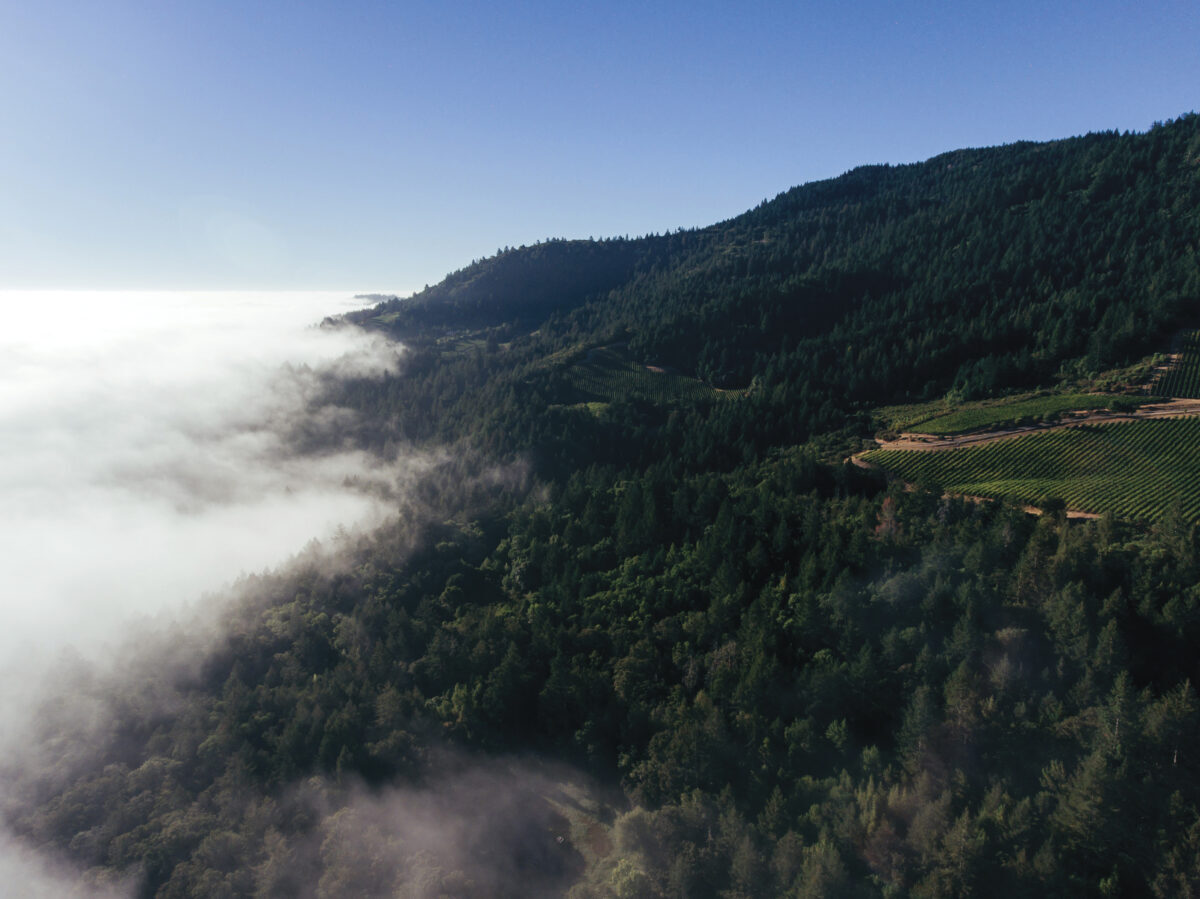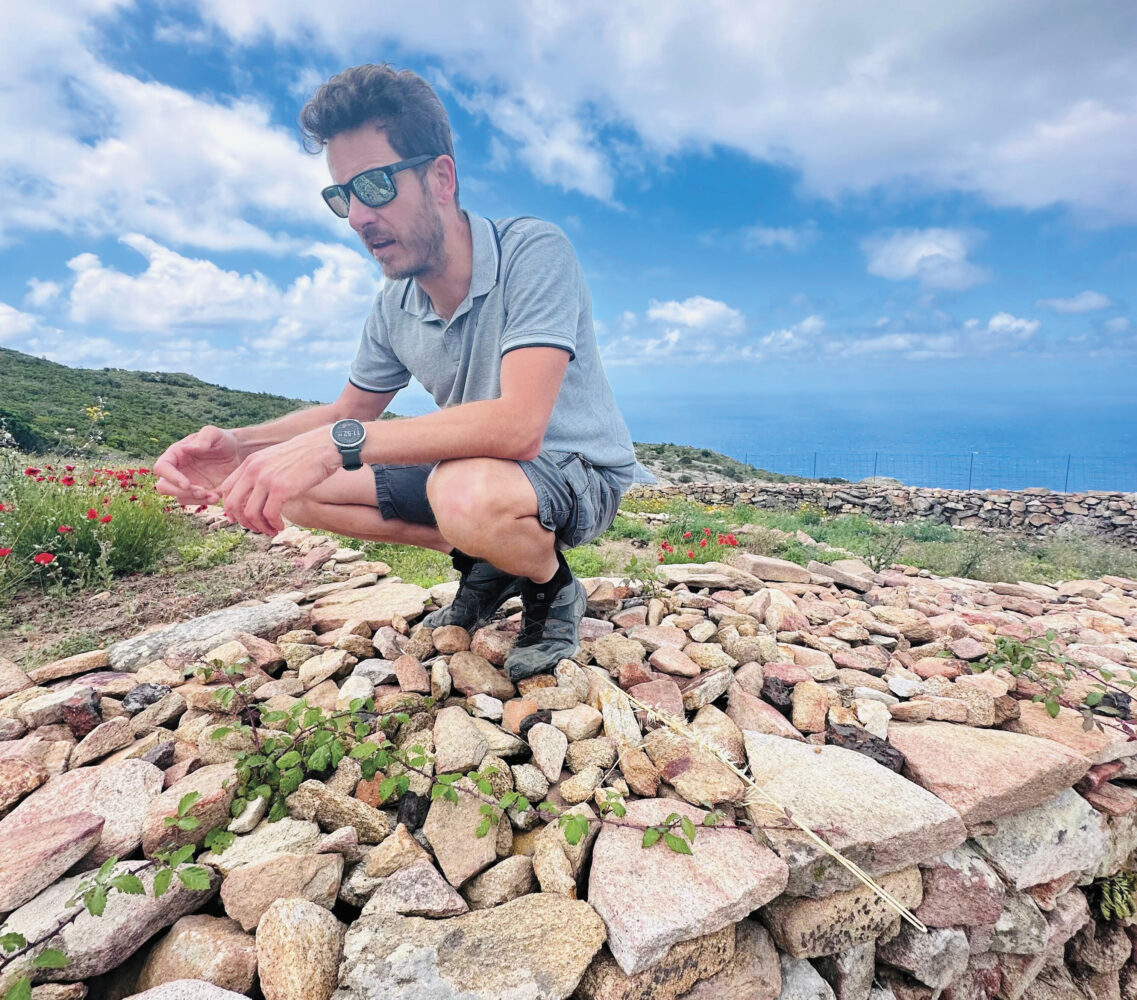home featured + SIP
Harvest Feature: Heroic Vineyards
The World’s Most Challenging Vineyards
WRITTEN BY Layne Randolph
|
Published On: October 30, 2024

Photo courtesy of Mt. Brave Wines
The island of Giglio lies an hour from the Tuscan coast. Vines have been growing on the island since at least Etruscan times. Its vineyards, which cascade down the hill from its peak to the sea, present a surreal and demanding environment to farm and harvest.
Cosimo Casini of Tenuta Isola nel Giglio aptly describes the situation, “The aspect that most characterizes the viticulture of the island of Giglio and even more so ours is linked to the impossibility of mechanization in the vineyard. Even bringing the necessary material to the vineyard is difficult.”
The term ‘heroic vineyard’ pays homage to the extraordinary challenges of cultivating grapes in extreme environments, so much so that every grape harvested is a triumph over adversity.

Cosimo Casini in the Scoglio Nero Vineyard // Photo by Layne Randolph
The path from the dirt mountain road to Tenuta Isola nel Giglio’s Scoglio Nero (black stone) Vineyard is a 15-minute walk on an untended rocky trail. “[To harvest], you go down the path still in the dark, aided by a headlamp, so as not to trip on the path due to the loose granite stones. Transporting the crates this year required a superhuman effort, leading us to walk the path up to 15 times each, with a crate on our backs, breaking the route in the most inaccessible parts and organizing real human chains to carry the harvested grapes to the van.”
Heroic defines the vineyard workers as much as the vineyards. “What was once done on the back of a mule or donkey today is done on the shoulders of the grape harvesters. We’re talking about kilometers of climbing up the cliffs to reach the means of transport, stuff from another time! In the recent past, even if the vineyards were more promising and qualitative, they were abandoned in favor of others more easily reachable and closer to the roads precisely because of these difficulties.”

Harvesting Giglios Heroic Vineyards // Photo by Tenuta Casenuove
The Italian Ministry of Agricultural, Food, and Forestry Policies (Ministero delle Politiche Agricole Alimentari e Forestali, or MiPAAF) defines the criteria for identifying heroic vineyards. The vineyards must possess at least one of the following: the slope of the land is greater than 30 percent, the average altitude is higher than 500 meters above sea level, the vineyards are on terraces and steps, or it involves the viticulture of small islands. Most, if not all, of Giglio’s vineyards meet every criterion.
Island viticulture brings a set of challenges beyond terrain. There are sun, salt, and wind considerations. On Giglio, ancient stone buildings the size of closets sit amid the vineyards, where field hands used to take a respite from the blazing sun. “Over the years, we have rediscovered and enhanced the same system used by the ancients before us: expertly built dry stone walls, with aqueducts and channels capable of trapping the little rainwater that falls in the winter months, to have it available when needed.
As for the wind, even in this case, you can have unpleasant surprises related to the strong lashes that can damage the plants or the saltiness that can arrive in the early stages, carried by the wind to burn the delicate vegetation. Also, in this case, the timeliness in following and supporting the vegetation with ties to the poles and wires helps us avoid such dangers.”
The Ansonica grape, grown in Giglio’s sandy, granitic terrain, produces a wine with unique qualities. Hardy and highly drought-resistant, the bush-trained vines concentrate on a small number of grapes that absorb the aromatic intensity of the Mediterranean terroir into Tenuta Isola nel Giglio’s IGT Toscana Bianco Ansonica. “This wine, vinified in compliance with the island tradition that saw the Romans, the Etruscans before them, and the Medici of Florence later, vinify this white grape with maceration as if it were a red grape, exploiting the maceration to extrapolate all the essence, all the potential contained in each precious grape.”

Scoglio Nero (black stones) of the Scoglio Nero Vineyard // Photo by Layne Randolph
Due to the cultivation conditions, the Scoglio Nero vineyards yield less than two tons per hectare. “Compared to vineyards with less limiting conditions, the ratio of one hectare (2.5 acres) on the Giglio island requires the same effort as if you had five to six hectares elsewhere.”
NAPA VALLEY’S “HEROIC” VINEYARDS
Mount Veeder has some of California’s most rugged and difficult vineyard terrain, up to 2,400 feet high, with yields averaging only 2 to 2.5 tons per acre. In these areas, nearly all vineyard work is done by hand out of necessity; machine work is minimal. The steep, winding slopes have shallow topsoil with minimal water retention and low nutrient content due to the steep runoff, making grape growing extremely challenging. Because of its low yields, it produces just 1.3 percent of the valley’s annual wine production.
Mount Veeder’s primary soil is from five-million-year-old pushed-up seabeds that formed the mountain, the only mountain of this kind in Napa Valley. Most of the valley was blanketed with volcanic ash, while Mount Veeder’s marine soil comprised shale, sandstone, and volcanic dust.
The harsh setting demands that vintners and growers like Mount Veeder AVA’s (American Viticultural Area’s) Mt. Brave Wines and Sequoia Grove Winery sacrifice for their craft, with minimal help from machinery and subsequent significantly higher farming costs. Luckily, these conditions induce stress into the vines, resulting in wines with pronounced depth, complexity, and intensity unique to the Mount Veeder AVA.
The winemaker for Mt. Brave Wines, Chris Carpenter, is more challenged than daunted by the prospect of farming on mountain terrain. “The fun of farming on a hillside [is] the myriad challenges and how to overcome them and farm strategically, qualitatively, and safely. With extreme angles on our slopes, like one of our main cab blocks at Mt Brave, the picking becomes a true test of endurance. This block has a run and rise of about 50 meters and a straight-up-and-down slope angle of close to 30 percent.”
Jake Terrell, Director of Vineyards at Sequoia Grove, described farming on Mt. Veeder. “Picking grapes on our Mount Veeder vineyard can be physically challenging. Having to hike up steep hills with a grape tub filled with 40+ pounds of grapes is not for the faint of heart. This requires staff who are in shape and trained appropriately for this type of work. Valley floor vineyards are much more forgiving and less demanding in all facets.”
“At our new Mount Veeder vineyard, a stunning property that rises from 1,500 to nearly 2,000 ft in elevation, slopes can range up to 30 percent. Because of that, wheel tractors cannot be utilized; we can only use “crawlers.” These crawlers haul small bins where the grapes are harvested, and due to the steep terrain, we have to limit the load to 2-bin trailers as opposed to the 3-bin trailers that we use on flat ground.”
The land stewards, vintners, and vineyard staff of Mount Veeder and Giglio Island, whether families who have tended the land for generations or visionary winemakers drawn to the challenge, cultivate their vineyards for profit, passion, and cultural pride. Despite the significant challenges, these vineyards represent a commitment to preserving a legacy of place. By working in harmony with the land and the environment, these vineyards produce wines with intense aromas and flavors that tell a story of courage and perseverance.
